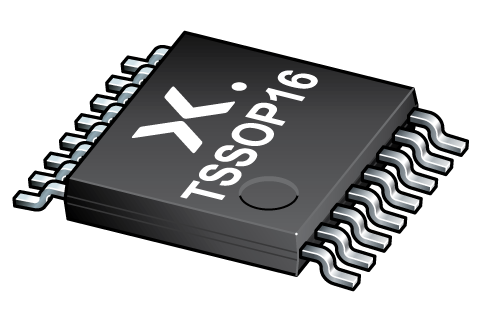Orderable parts
| Type number | Orderable part number | Ordering code (12NC) | Package | Buy from distributors |
|---|---|---|---|---|
| 74LV165APW | 74LV165APW,118 | 935273177118 | SOT403-1 | Order product |

Register once, drag and drop ECAD models into your CAD tool and speed up your design.
Click here for more information8-bit parallel-in/serial-out shift register
The 74LV165A is an 8-bit parallel-load or serial-in shift register with complementary serial outputs (Q7 and Q7) available from the last stage. When the parallel-load input (PL) is LOW, parallel data from the inputs D0 to D7 are loaded into the register asynchronously. When input PL is HIGH, data enters the register serially at the input DS. It shifts one place to the right (Q0 → Q1 → Q2, etc.) with each positive-going clock transition. This feature allows parallel-to-serial converter expansion by tying the output Q7 to the input DS of the succeeding stage.
The clock input is a gate-OR structure which allows one input to be used as an active LOW clock enable input (CE) input. The pin assignment for the inputs CP and CE is arbitrary and can be reversed for layout convenience. The LOW-to-HIGH transition of the input CE should only take place while CP HIGH for predictable operation.
Schmitt-trigger action at all inputs, makes the circuit tolerant for slower input rise and fall times. It is fully specified for partial-power-down applications using IOFF. The IOFF circuitry disables the output, preventing the damaging current backflow through the device when it is powered down.
Wide supply voltage range from 2.0 V to 5.5 V
Synchronous parallel-to-serial applications
Synchronous serial input for easy expansion
Latch-up performance exceeds 250 mA
CMOS LOW power consumption
5.5 V tolerant inputs/outputs
Direct interface with TTL levels (2.7 V to 3.6 V)
Power-down mode
Complies with JEDEC standards:
JESD8-5 (2.3 V to 2.7 V)
JESD8B/JESD36 (2.7 V to 3.6 V)
JESD8-1A (4.5 V to 5.5 V)
HBM: ANSI/ESDA/JEDEC JS-001 class 2 exceeds 2000 V
CDM: ANSI/ESDA/JEDEC JS-002 class C3 exceeds 1000 V
Specified from -40 °C to +85 °C
| Type number | VCC (V) | Logic switching levels | Output drive capability (mA) | tpd (ns) | fmax (MHz) | Nr of bits | Power dissipation considerations | Tamb (°C) | Rth(j-a) (K/W) | Ψth(j-top) (K/W) | Rth(j-c) (K/W) | Package name |
|---|---|---|---|---|---|---|---|---|---|---|---|---|
| 74LV165APW | 1.0 - 5.5 | TTL | ± 12 | 7.5 | 115 | 8 | low | -40~85 | 124 | 4.4 | 53.9 | TSSOP16 |
| Model Name | Description |
|---|---|
|
|
| Type number | Orderable part number, (Ordering code (12NC)) | Status | Marking | Package | Package information | Reflow-/Wave soldering | Packing |
|---|---|---|---|---|---|---|---|
| 74LV165APW | 74LV165APW,118 (935273177118) |
Active | LV165A |

TSSOP16 (SOT403-1) |
SOT403-1 |
SSOP-TSSOP-VSO-WAVE
|
SOT403-1_118 |
| Type number | Orderable part number | Chemical content | RoHS | RHF-indicator |
|---|---|---|---|---|
| 74LV165APW | 74LV165APW,118 | 74LV165APW |
|
|
| File name | Title | Type | Date |
|---|---|---|---|
| 74LV165A | 8-bit parallel-in/serial-out shift register | Data sheet | 2024-04-18 |
| AN90063 | Questions about package outline drawings | Application note | 2025-10-22 |
| SOT403-1 | 3D model for products with SOT403-1 package | Design support | 2020-01-22 |
| Nexperia_package_poster | Nexperia package poster | Leaflet | 2020-05-15 |
| TSSOP16_SOT403-1_mk | plastic, thin shrink small outline package; 16 leads; 0.65 mm pitch; 5 mm x 4.4 mm x 1.1 mm body | Marcom graphics | 2017-01-28 |
| SOT403-1 | plastic, thin shrink small outline package; 16 leads; 5 mm x 4.4 mm x 1.2 mm body | Package information | 2023-11-08 |
| SOT403-1_118 | TSSOP16; Reel pack for SMD, 13"; Q1/T1 product orientation | Packing information | 2020-04-21 |
| 74LV165APW_Nexperia_Product_Reliability | 74LV165APW Nexperia Product Reliability | Quality document | 2025-03-20 |
| SSOP-TSSOP-VSO-WAVE | Footprint for wave soldering | Wave soldering | 2009-10-08 |
If you are in need of design/technical support, let us know and fill in the answer form we'll get back to you shortly.
The Nexperia Longevity Program is aimed to provide our customers information from time to time about the expected time that our products can be ordered. The NLP is reviewed and updated regularly by our Executive Management Team. View our longevity program here.
| File name | Title | Type | Date |
|---|---|---|---|
| SOT403-1 | 3D model for products with SOT403-1 package | Design support | 2020-01-22 |
| Model Name | Description |
|---|---|
|
|
| Type number | Orderable part number | Ordering code (12NC) | Status | Packing | Packing Quantity | Buy online |
|---|---|---|---|---|---|---|
| 74LV165APW | 74LV165APW,118 | 935273177118 | Active | SOT403-1_118 | 2,500 |
|
As a Nexperia customer you can order samples via our sales organization.
If you do not have a direct account with Nexperia our network of global and regional distributors is available and equipped to support you with Nexperia samples. Check out the list of official distributors.
The interactive datasheets are based on the Nexperia MOSFET precision electrothermal models. With our interactive datasheets you can simply specify your own conditions interactively. Start by changing the values of the conditions. You can do this by using the sliders in the condition fields. By dragging the sliders you will see how the MOSFET will perform at the new conditions set.